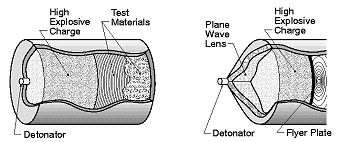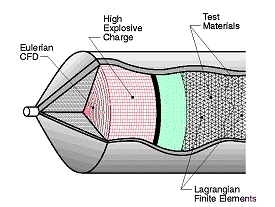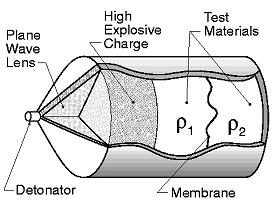
Spring/Summer 1999
Volume 6, Issue 2
Spring/Summer 1998
Volume
3, Issue 1
January 1995
Volume
2, Issue 4
October 1994
Volume
2, Issue 1
January 1994
ASCI Center of Excellence Caltech to Construct Virtual Shock Physics Facility
CRPC site Caltech is one of five major American universities recently selected to collaborate with three Department of Energy (DOE) laboratories in a $250 million initiative to help advance high-performance computer simulation capabilities. The Accelerated Strategic Computing Initiative (ASCI), led by DOE National Laboratories Lawrence Livermore, Sandia, and CRPC site Los Alamos, was formed to accelerate commercial computing development to achieve performance on the order of 400 times more powerful than today's machines by the years 2004 or 2005.
The ASCI Program Centers of Excellence, also called Academic Strategic Alliances Program (ASAP) centers, are Caltech, Stanford University, the University of Chicago, the University of Utah/Salt Lake, and the University of Illinois at Urbana/Champaign, a CRPC affiliated site. They have each proposed very large-scale applications that collectively drive the development of modeling and computing capabilities. This endeavor will assist the three national laboratories in developing and validating the technologies needed to certify the reliability of the nation's nuclear weapons stockpile without underground testing, in support of the Clinton administration's nuclear test ban objectives.
 Led by CRPC researcher Daniel Meiron of Caltech, the Center for Simulating Dynamic Response of Materials is constructing a virtual shock physics facility in which the full three-dimensional response of a variety of target materials can be computed for a wide range of compressive, tensional, and shear loadings, including those loadings produced by detonation of energetic materials. The accompanying figures show examples of the configurations to be
simulated. The goals are to:
Led by CRPC researcher Daniel Meiron of Caltech, the Center for Simulating Dynamic Response of Materials is constructing a virtual shock physics facility in which the full three-dimensional response of a variety of target materials can be computed for a wide range of compressive, tensional, and shear loadings, including those loadings produced by detonation of energetic materials. The accompanying figures show examples of the configurations to be
simulated. The goals are to:
- Facilitate computation of a variety of experiments in which strong shock and detonation waves are made to impinge on targets consisting of various combinations of materials,
- Compute the subsequent dynamic response of the target materials, and
- Validate these computations against experimental data.
 |
 |
- Modeling and Simulation of Fundamental Processes in Detonation
- Modeling Dynamic Response of Solids
- First Principles Computation of Materials Properties
- Compressible Turbulence and Mixing
- Computational and Computer Science Infrastructure
In addition to serving as Principal Investigator of the center, Meiron is lead investigator of the Compressible Turbulence and Mixing research initiative. James Pool is Executive Director of the center and is a researcher in the Computational and Computer Science Infrastructure group, led by Paul Messina. Other CRPC Caltech researchers in this group are K. Mani Chandy, Herbert Keller, and Carl Kesselman. CRPC collaborators from other sites include Jack Dongarra, University of Tennessee at Knoxville; Dennis Gannon, Indiana University; and Daniel Reed, University of Illinois at Urbana/Champaign.
Caltech and the other ASAP centers were initially awarded five-year contracts to interact with each of the three national laboratories on their projects. The awards are approximately $3 million per center and will grow to an average of $5 million annually. The ASAP will be a 10-year program, during which the centers will be given access to approximately 10 percent of the ASCI platforms at the Defense Programs laboratories.
For more information on ASCI and ASAP, see http://www.llnl.gov/asci/alliances/. For more details on the work being conducted at Center for Simulating Dynamic Response of Materials at Caltech, see http://www.cacr.caltech.edu/ASAP/.